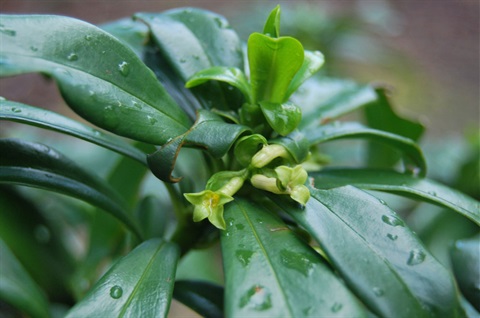Daphne laurel

Daphne laurel is a highly invasive ornamental garden plant. In Fern Tree it has moved into bushland around Clegg Road and Grays Road.
This weedy plant has a small range, and so we hope to eradicate it.
Daphne laurel is a small, long-lived shrub. It thrives in full to partial shade, in wet, temperate forests. Originally from Europe, it has been found in the foothills of Kunanyi / Mt Wellington. It is believed it originated from a local garden.
It is an attractive plant, with:
- glossy-green alternating leaves
- small mauve, white, yellow, or greenish-yellow and fragrant flowers that form in clusters near branch tips
- small fleshy fruits that become bluish-black when ripe.
Not only is this weed an environmental threat, it is also highly toxic to humans. Berry consumption has been linked to the death of a child in Canada. Contact with the sap can cause irritation and blistering of the skin.
Its scientific name is Daphne laureola, but it is commonly known as Daphne laurel or spurge laurel.
It has become naturalised in parts of the US, Canada, and New Zealand. There it forms dense stands that out-compete native vegetation.
It is believed the foothills of Kunanyi / Mt Wellington, near Fern Tree, is the only place in Australia where this ornamental plant has become an environmental weed.
The City of Hobart has worked with NRM South and the Fern Tree community to eradicate Daphne laurel. Volunteers from the City's Bushcare program have also played an important role in tackling this weed. They work on private properties to map the extent of the weed, and remove larger stands with help from weed contractors.
Distribution of this environmental weed in Hobart is limited, and complete eradication is an achievable aim.
If you live around Clegg or Grays roads in Fern Tree, or would like to help the local Bushcare group eradicate this weed, please contact the City of Hobart Bushcare team on 03 6238 2884.